The gold price took a couple of small steps higher in GLOBEX trading in the Far East on their Friday -- and that lasted until a few minutes past 3 p.m. China Standard Time on their Friday afternoon. From that juncture it was sold very quietly and a bit unevenly lower until the jobs report hit the tape at 8:30 a.m. in Washington. It jumped up a bunch at that point, but ran into selling pressure almost right away -- and it was turned lower starting at precisely 9 a.m. EST. That continued until the 10 a.m. EST afternoon gold fix in London was put to bed -- and then it jumped up a bunch more over the following fifteen minutes. >From that point it crawled quietly higher until around 2:15 p.m. in after-hours trading -- and then crept quietly lower from there until shortly before the 5 p.m. EST close.
The low and high ticks in gold were reported as $1,835.20 and $1,875.20 in the February contract. The February/April price spread differential in gold at the close in New York on Friday afternoon was $16.20...April/June was also $16.20 -- and June/August was $16.70 an ounce.
Gold finished the Friday trading session in New York at $1,865.70 spot, up $32.50 from Thursday's close. Net volume was certainly on the heavier side, but not nearly as heavy as one might expect considering the price move, at a bit under 196,500 contracts -- and there were about 20,500 contracts worth of roll-over/switch volume on top of that...mostly into April, but a bit into June as well.
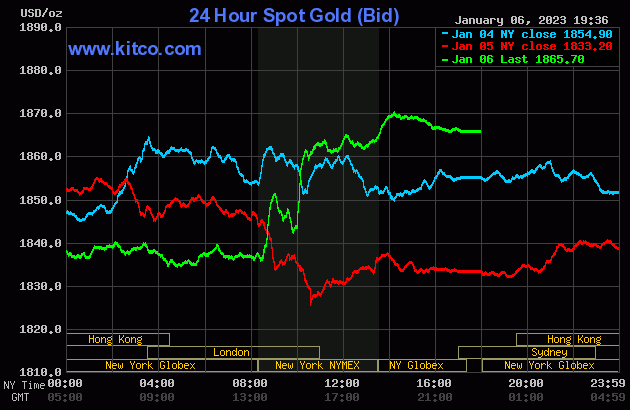
Silver's price path was managed in a similar fashion as gold's, as neither of its big rally attempts during COMEX trading in New York were allowed to get far, either.
The low and high ticks in silver were recorded by the CME Group as $23.345 and $24.055 in the March contract. The March/May price spread differential in silver at the close in New York yesterday was 18.2 cents...May/July was 19.8 cents -- and July/September was 21.0 cents an ounce.
Silver was closed in New York on Friday afternoon at $23.82 spot, up 60 cents from Thursday. Net volume was, very surprisingly, nothing at all special at 52,000 contracts -- and there were around 4,050 contracts worth of roll-over/ switch volume in this precious metal...mostly into May, but with a bit into July and September as well. I'll have more on this in The Wrap.
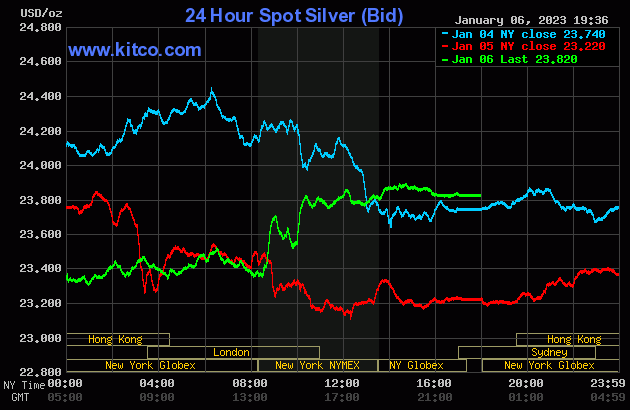
Platinum crawled a bit higher in price in GLOBEX trading in the Far East -- and that also lasted until a few minutes after 3 p.m. China Standard Time on their Friday afternoon...just like for gold. It was then sold lower -- and its low tick was set around 10:45 a.m. in Zurich. It chopped a few dollars higher from there until it also took off on the jobs report at 8:30 a.m. EST. That rally also ran into 'resistance' -- and its high tick was set around 12:25 p.m. in COMEX trading in New York. Then, like both silver and gold, it was sold a hair lower until trading ended at 5:00 p.m. EST. Platinum was closed at $1,090 spot, up 32 bucks from Thursday.
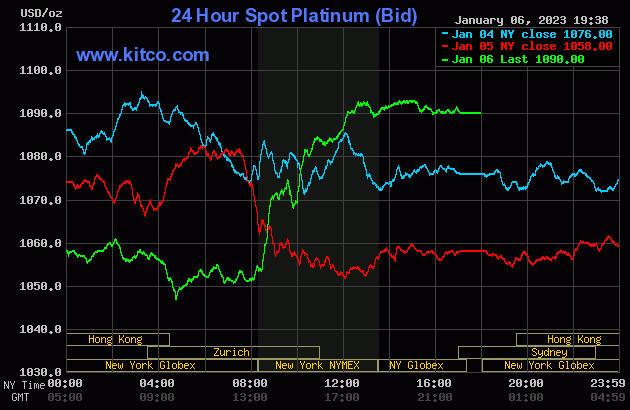
The palladium price stair-stepped its way quietly higher until around 1 p.m. China Standard Time in GLOBEX trading on their Friday afternoon. It then traded flat until like gold and platinum, was sold unevenly lower starting minutes after 3 p.m. CST. It also took off higher at 8:30 a.m. in New York -- and that rally petered out around 2:15 p.m. in the very thinly-traded after-hours market. Palladium finished the Friday trading session in New York at $1,739 spot, up 69 dollars on the day.

Based on the kitco.com spot closing prices in silver and gold posted above, the gold/silver ratio worked out to 78.3 to 1 on Friday...compared to 78.9 to 1 on Thursday.
Here's Nick Laird's 1-year Gold/Silver Ratio chart, updated with this past week's data and, as always, Friday's GSR data point it not on it. Click to enlarge.
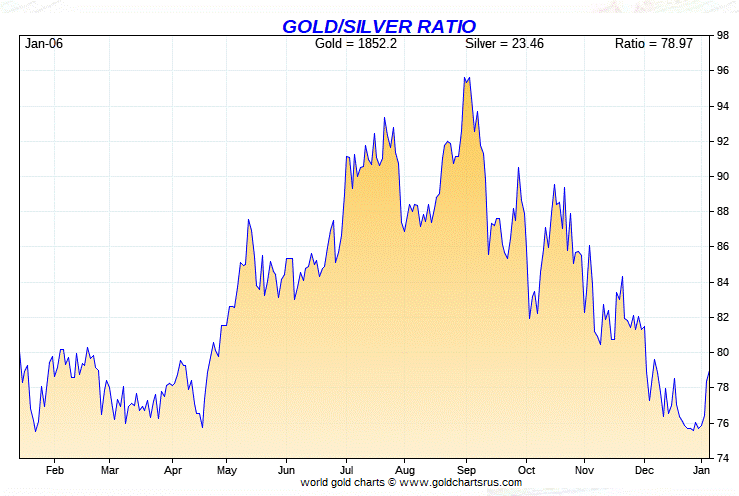
![]()
The dollar index closed very late on Thursday afternoon in New York at 105.04 -- and then opened up 2 basis points once trading commenced at 7:45 p.m. EST on Thursday evening, which was 8:45 a.m. China Standard Time on their Friday morning. It didn't do much from there until around 12:45 p.m. CST -- and a very quiet rally began at that juncture, that lasted until 1:05 p.m. GMT in London/8:05 a.m. EST in New York. It was then sold lower until 8:51 a.m...rallied quietly and unevenly until it fell out of bed at the 10 a.m. EST afternoon gold fix in London...and then down it went. That sell-off ended around 2:30 p.m. -- and it then traded flat until the market closed at 5:00 p.m. EST.
The dollar index finished the Friday trading session in New York at 103.88...down 116 basis points from its close on Thursday.
Here's the DXY chart for Friday, thanks to marketwatch.com as usual. Click to enlarge.
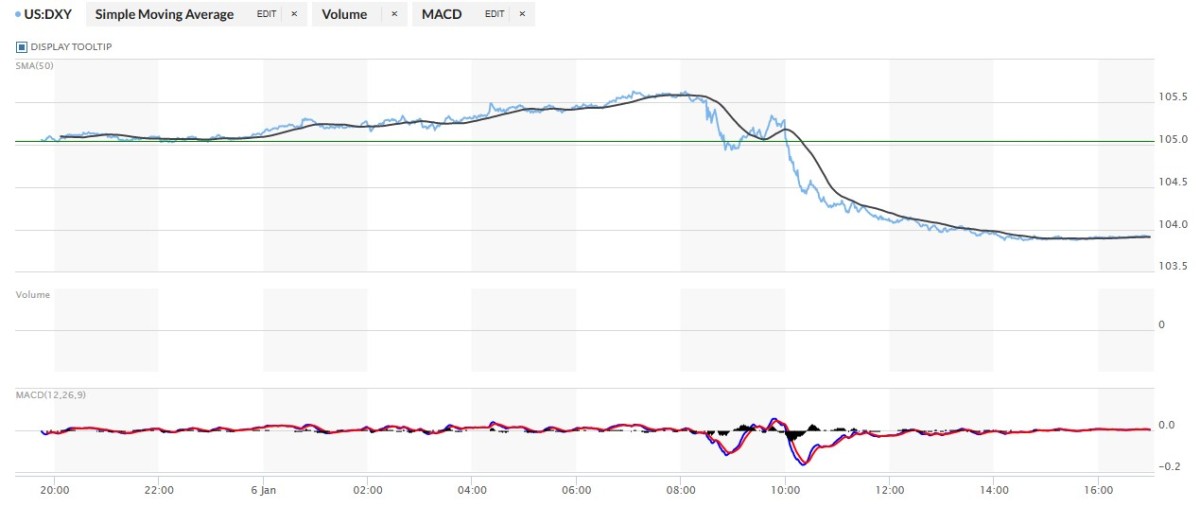
And here's the 5-year DXY chart that appears in this spot every Saturday... courtesy of the folks over at the stockcharts.com Internet site. The delta between its close...103.65...and the close on the DXY chart above, was 23 basis point below its spot close. Click to enlarge as well.
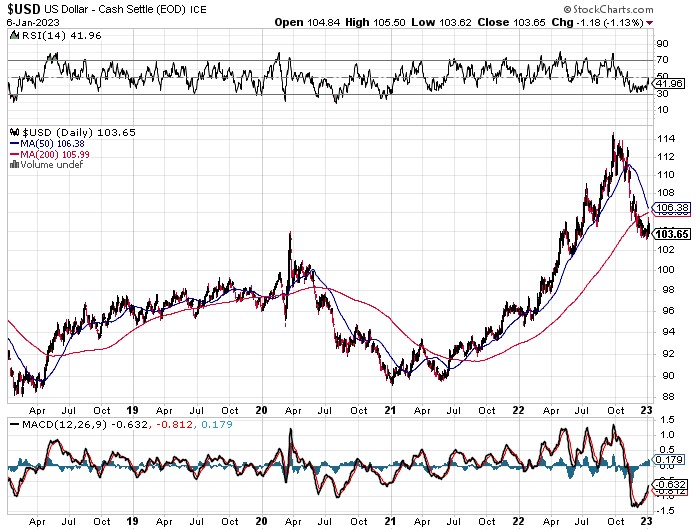
There was some obvious correlation between the currencies and precious metal prices yesterday. But it was equally obvious that the correlation would have been far greater if the commercial traders of whatever stripe hadn't appeared during morning trading session on the COMEX in New York.
U.S. 10-Year Treasury: 3.5690%...down 0.1510 (-4.06%)...as of 02:59 p.m. EST -- and you'll excuse me for thinking that the Fed was a heavy buyer across the yield curve yesterday.
Here's the 5-year 10-year U.S. Treasury chart from the yahoo.com Internet site -- and it puts the yield curve into a somewhat longer-term perspective. Click to enlarge.
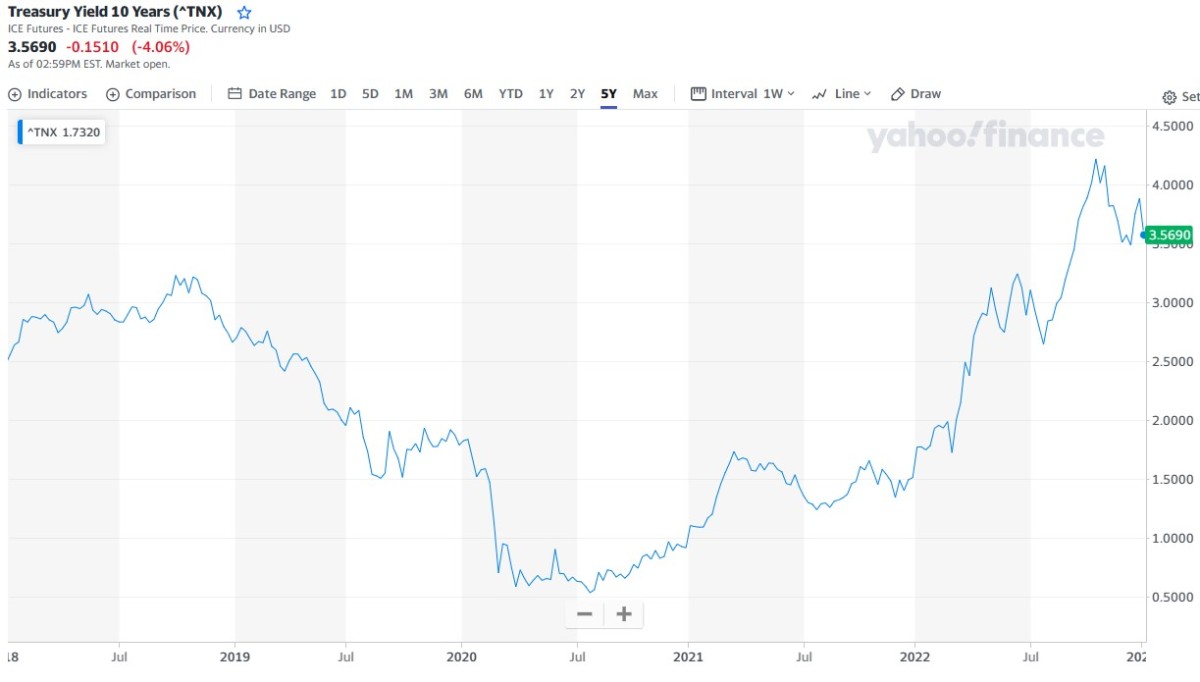
It's more than obvious, as Gregory Mannarino has been pointing out all week, that the drop in the 10-year that's been going on all week long, didn't happen because of free-market forces. Gregory had some rather cryptic comments about this in his Friday rant further down.
![]()
The gold shares gapped up a bit at the 9:30 opens in New York on Friday morning, but were hammered back to the unchanged mark within twenty minutes. They then rallied anew until a few minutes before 11 a.m. -- and despite the fact that the gold price continued to rise [albeit unevenly] until shortly after 2 p.m...the gold stocks wandered quietly lower until the markets closed at 4:00 p.m. EST. The HUI closed up only 1.88 percent. Like you, I was totally underwhelmed.
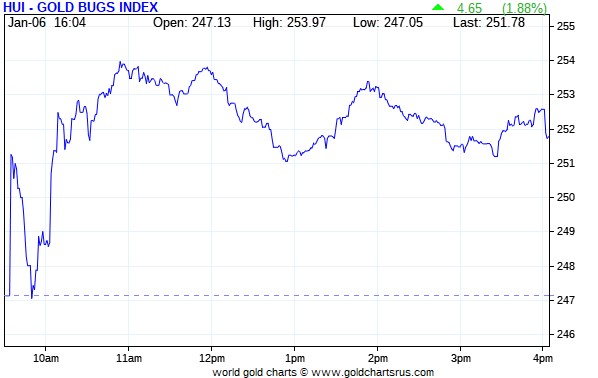
Computed manually, the new Silver 11/Silver Sentiment Index closed higher by 2.79 percent.
And here's Nick's old 1-year Silver Sentiment/Silver 7 Index chart, updated with Friday's candle. Click to enlarge.
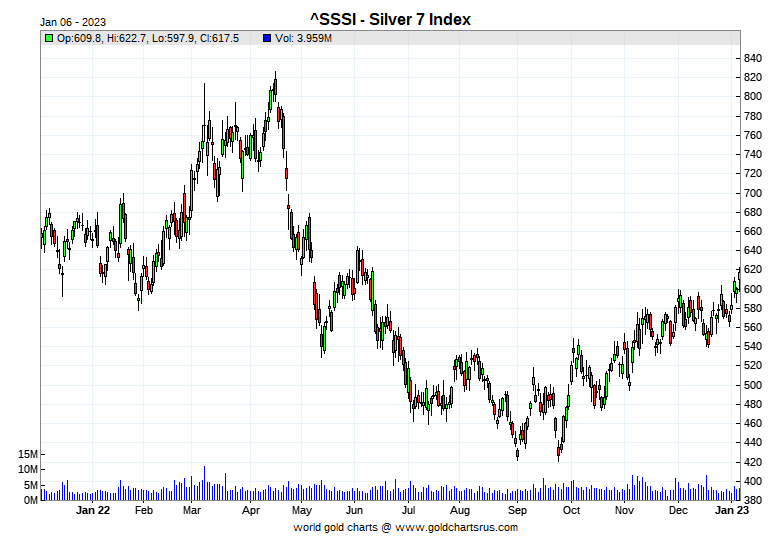
The 'star' was Hecla Mining, as it closed up 4.41 percent...followed closely by Fortuna Silver Mines and Coeur Mining, as they closed higher by 4.30 and 4.25 percent respectively. The dog was Aya Gold & Silver, as it closed down 1.93 percent on the day. I didn't see any news on their website to account for that underperformance.
The latest silver eye candy from the reddit.com/Wallstreetsilver crowd is linked here.
![]()
Because of the holiday-shortened week, plus the fact that it's only the first week of the New Year, I only have the month-to-date chart for you today. It shows the changes in gold, silver, platinum and palladium in both percent and dollar and cents terms, as of their Friday closes in New York — along with the changes in the HUI and Nick's Silver 7/Silver Sentiment Index.
Here's the month-to-date chart -- and with silver down a bit on the week, their associated equities outperformed their golden cousins. At the moment, I wouldn't read too much into that. Click to enlarge.
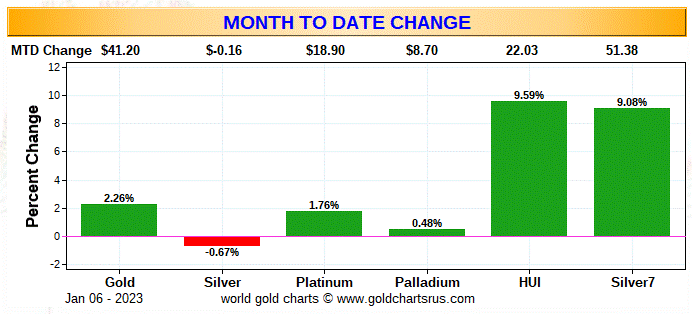
The weekly and year-to-date charts will be back in their usual spots in next Saturday's column.
It's a brand new year -- and it's off to a good start. As I mentioned earlier this past week, I suspect that those individuals or hedge fund managers that sold for tax-loss reasons in December, were piling back in as soon as the New Year began -- and thus the tremendous performance of the precious metal equities during this past holiday-shortened week.
![]()
The CME Daily Delivery Report for Day 6 of January deliveries showed that 19 gold -- and 3 silver contracts were posted for delivery within the COMEX-approved depositories on Tuesday.
In gold, the three biggest of the four short/issuers in total were JPMorgan, Advantage and Marex Spectron, with 9,6 and 3 contracts...JPMorgan from its house account. There were six long/stoppers in total -- and the two largest there were Australia's Macquarie Futures and Advantage, as they picked up 7 contracts each for their respective client accounts.
In silver, the sole short/issuer was Advantage out of its client account -- and three different long/stoppers picked up 1 contract each.
The link to yesterday's Issuers and Stoppers Report is here.
So far in January, there have been 743 gold contracts issued/reissued and stopped -- and that number in silver is 815 COMEX contracts. There have also been 2,041 platinum contracts issued/reissued and stopped in its current delivery month.
The CME Preliminary Report for the Friday trading session showed that gold open interest in January dropped by 8 contracts, leaving just 57 left, minus the 19 contracts mentioned a few paragraphs ago. Thursday's Daily Delivery Report showed that 20 gold contracts were posted for delivery on Monday, so that means that 20-8=12 more gold contracts just got added to January deliveries. Silver o.i. in January remained unchanged at 22 contracts, minus the 3 contracts mentioned a few paragraphs ago. Thursday's Daily Delivery Report showed that 2 silver contracts were actually posted for delivery on Monday, so that means that 2 more silver contracts were added to January deliveries.
Total gold open interest at the close on Friday rose by 10,467 COMEX contracts -- and total silver o.i. also rose, but only by 1,401 contracts. Both numbers are subject to some revision by the time the final figures are posted on the CME's website later on Monday morning CST.
![]()
For the third day in a row there were no reported changes in GLD...which should certainly be owed a bunch of gold considering the price action of this past week. Maybe on Monday. But there was a very hefty deposit into SLV, as an authorized participant added 2,944,096 troy ounces of silver.
Considering the price action in silver this past week, it's possible that the above amount was added to cover an existing short position -- and if it was, it won't show up in this coming Wednesday's short report, as the cut-off for that was on December 30.
In other gold and silver ETFs and mutual funds on Planet Earth on Friday, net of any changes in COMEX, GLD and SLV inventories, there were a net 993 troy ounces of gold added, but a net 360,950 troy ounces of silver was withdrawn. Those net silver withdrawals involved six different depositories in total.
And nothing from the U.S. Mint.
![]()
There was a very hefty amount of activity in gold over at the COMEX-approved depositories on the U.S. east coast on Thursday. Nothing was reported received, but 181,685.283 troy ounces/5,651 kilobars were shipped out.
Except for the two kilobars that departed Brink's, Inc...the remaining 4,649 kilobars left JPMorgan.
There was no paper activity -- and the link to Thursday's COMEX activity in gold, is here.
There was fairly decent activity in silver, as 586,073 troy ounces/one truckload was reported received -- and all of that amount ended up at JPMorgan. There were 249,954 troy ounces shipped out.
There were four different depositories involved in the 'out' category -- and the largest two were the 200,849 troy ounces that left Loomis International... followed by the 41,120 troy ounces that departed CNT.
There was a bit of paper activity, as 15,322 troy ounces were transferred from the Registered category and back into Eligible over at JPMorgan.
The link to all of Thursday's COMEX silver activity, is here.
There was a tiny bit of activity over at the COMEX-approved kilobar depositories in Hong Kong on their Thursday. Nothing was reported received -- and 493 kilobars were shipped out...401 from Brink's, Inc. -- with the remaining 92 kilobars departing Loomis International. The link to this, in troy ounces, is here.
![]()
Here are the usual 20-year charts that show up in this space in every Saturday column. They show the total amount of physical gold and silver held in all know depositories, ETFs and mutual funds as of the close of business on Friday.
During the week just past, there was a net 224,000 troy ounces of gold removed -- and a net 1.776 million troy ounces of silver was taken out as well. Click to enlarge for both.
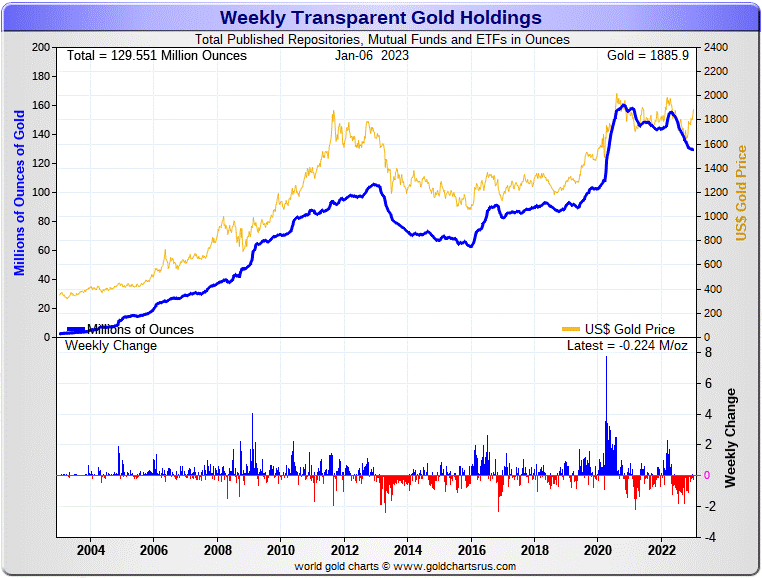
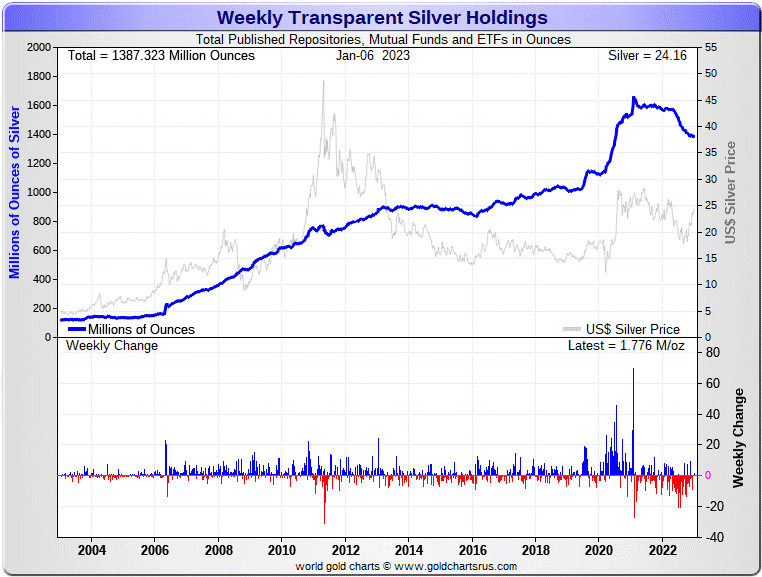
According to Nick Laird's data on his website, there has been a net 136,000 troy ounces of goldremoved -- and a net 7.744 million troy ounces of silver removed as well, from all the world's known depositories, mutual funds and ETFs during the last four weeks.
The 4-week gold number is down 191,000 troy ounces from a week ago -- and that silver number is down 2,223,000 troy ounces over the same time period.
In silver over the last four weeks...there was a net 1.702 million troy ounces added to COMEX inventories -- and a net 6.679 million troy ounces were removed from SLV. That left the remaining net 2.767 troy ounces that were taken out of the rest of the world's ETFs and mutual funds -- and that's despite the fact that 702,000 troy ounces were added to Sprott during that period, plus the 204,000 troy ounces into Deutsche Bank.
The other big withdrawals over the last four weeks have been the 1.585 million troy ounces out of Switzerland's ZKB...1.075 million troy ounces from SIVR... 342,000 troy ounces from GoldMoney -- and 401,000 from BullionVault.
In gold over the last month, the biggest withdrawal were the 500,000 troy ounces out of the COMEX -- and mostly JPMorgan-related. The biggest deposits went into GLD/GLDM...400,000 troy ounces. The rest, around 36,000 troy ounces, were removed from the other gold ETFs and mutual funds.
What's amazing about these depository numbers over the last four weeks is that despite the big rallies in both silver and gold over the last several months, precious metals are still leaving all these depositories on a net basis...even once the shenanigans in COMEX, GLD & SLV withdrawals are factored out.
The physical shortage in silver at the both the wholesale and retail level continued this past week -- although it has become obvious that retail sales have slowed down quite a bit over the holidays. A number of retailers have a lot of silver bars and rounds/coins still on back-order -- and have no inventories at all in a lot of items they normally keep in stock. However, there's enough retail bullion around -- and demand has softened enough, that premiums on them have fallen quite a bit.
But the real shortage that matters is at the wholesale level in silver at the COMEX -- and in SLV. That became obvious during the December delivery month in regards to Canada's BMO [Bank of Montreal} Capital, as it took them quite some time to scrounge up the silver necessary to deliver into their short position. There also appears to be some physical tightness in gold at the wholesale level as well.
But, as you're more than aware, this extraordinary demand has not yet been allowed to manifest itself in their respective prices. The Big 4/8 commercial shorts still have them in their iron grip.
Of course not to be forgotten about with regards to SLV, is this not so little matter of the 50.36 million shares currently sold short in this ETF. That's up 5 million shares/11% as of the last published short report on December 27. The reason that number remains stubbornly high is certainly because the physical metal doesn't exist to deposit without driving the silver price to the moon. So instead of depositing the physical metal, the mostly one or two major authorized participants involved [according to Ted] are shorting the shares is lieu of that.
The next short report is due out on Wednesday, January 11...for positions held at the close of business on Friday, December 30.
Then there's still that other little matter of the 1-billion ounce short position held by Bank of America...with JPMorgan & Friends on the long side. Ted says it hasn't gone away -- and as he pointed out, the latest OCC Report, for positions held at the end of September, shows that it's still there, but now hidden by their market-neutral spread trades in gold.
![]()
The Commitment of Traders Report, for positions held at the close of COMEX trading on Tuesday, was all one could have hoped for, as there was only a tiny increase in the Commercial net short position in silver -- and much smaller than expected increase in gold.
In silver, the Commercial net short position increased by a smallish 1,294 COMEX contracts, or 6.47 million troy ounces of the stuff.
They arrived at that number by adding 185 contracts to their long position, but also added 1,479 short contracts -- and it's the difference between those two numbers that represents their change for the reporting week.
Under the hood in the Disaggregated COT Report, the Managed Money traders were sellers, as they decreased their net long position by 1,039 COMEX contracts. The Other Reportables and Nonreportable/small traders were buyers, as both increased their net long positions...the former by 946 contracts -- and the latter by 1,387 contracts. They did this mostly be reducing their gross short positions, rather than adding new longs.
Doing the math: 946 plus 1,387 minus 1,039 equals 1,294 COMEX contracts, the change in the Commercial net short position.
The Commercial net short position in silver now sits at 221.06 million troy ounces in Friday's report. That's up from the 214.59 million troy ounces that they were net short in last Friday's COT Report...an increase of 6.47 million troy ounces. That change is obviously the headline number mentioned further up, which it has to be.
The Big 8 shorts decreased their short position to 66,259 COMEX contracts -- and that's down an insignificant 30 contracts from the 66,289 contracts they were short in last Friday's COT Report...so call it unchanged.
The Big 4 shorts also decreased their short position by a paltry amount...108 COMEX contracts, from 44,192 contracts in last week's report, down to 44,084 contracts in this Friday's COT report.
That means that the Big '5 through 8' shorts increased their short position by an equally paltry 108-30=78 COMEX contracts.
It was Ted's raptors, the 16 small commercial traders other that the Big 8 shorts, that did all the selling during the reporting week, as they reduced their long position from 23,370 COMEX contracts, down to around 22,050 COMEX contracts...a drop of approximately 1,320 COMEX contracts.
And as I continue to mention in this space, considering where we are at this point in the rally in silver, I'm more than amazed that the raptors are still long the amount that they are.
Here's Nick's 9-year COT chart for silver, updated with this week's data points. Click to enlarge.
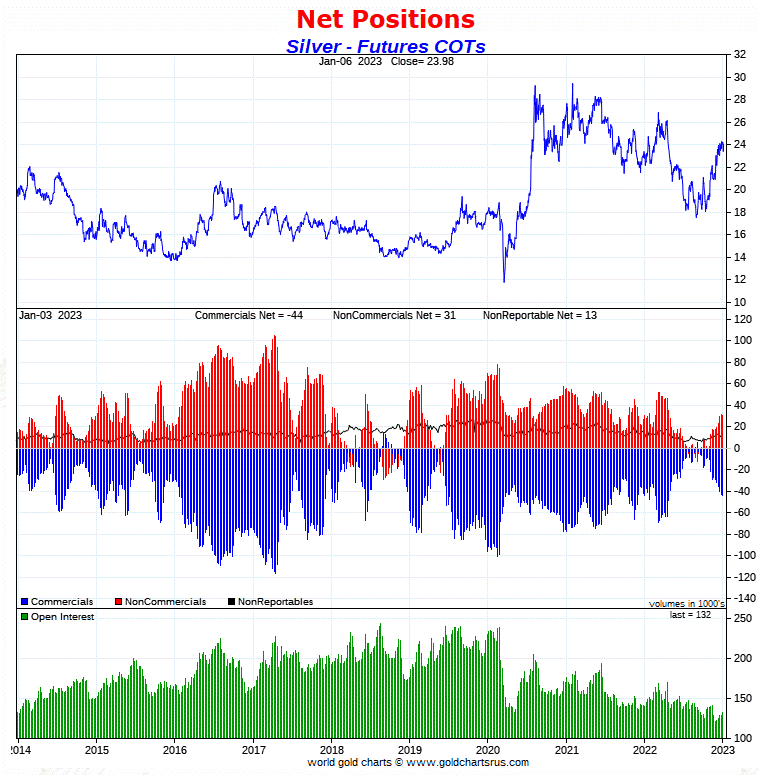
So, of the increase of 1,294 COMEX contracts in the Commercial net short position in silver during the week just past, all of it plus a bit more...1,320 COMEX contracts of that amount...was long selling by Ted's raptors and, as I've already pointed out, their selling of long positions has the mathematical effect of increasing the Commercial net short position, which is not really an increase at all.
Since the last Bank Participation Report on December 9, the Big 8 commercial shorts have only added about 2,900 contracts to their short position during this ongoing silver rally. The rest has been Ted's raptors selling long positions ...about 9,050 contracts worth.
I suppose the Big commercial shorts could rig another sell-off, as they're very good at that. But there's not an overly large amount of low-hanging fruit for them to get, as they've been very reluctant to add to their short position over the last couple of months -- and besides which, all lower prices would do is encourage Ted's raptors to add to their already massive long position, which would be in direct competition with the Big 8 shorts attempts to cover.
I'll have more on this in the Bank Participation discussion further down.
So, from a COMEX futures market perspective, the path of least price resistance in silver is still higher...much higher.
![]()
In gold, the commercial net short position rose, but only by 6,198 COMEX contracts, or 619,800 troy ounces of the stuff. I was very relieved to see that, as I was expecting a number of more than double that amount, so this was pleasant surprise.
They arrived at that number by reducing their long position by 3,224 contract -- and also added 2,974 short contracts. It's the sum of those two numbers that represent their change for the reporting week.
Under the hood in the Disaggregated COT Report, all three categories of traders added to their net long positions...the Managed Money traders by only 3,704 COMEX contracts...the Other Reportables by 1,082 contracts -- and the Nonreportable/small traders by 1,412 contracts.
Doing the math: 3,704 plus 1,082 plus 1,412 equals 6,198 COMEX contracts, the change in the commercial net short position.
The commercial net short position in gold now sits at 15.997 million troy ounces, which is up 0.619 million troy ounces from the 15.378 million troy ounces they were short in last Friday's COT Report. That change is the headline number posted above, which it has to be...with the tiny difference being a rounding error.
The short position of the Big 8 commercial traders worked out to 21.12 million troy ounces, which is up 0.35 million troy ounces from the 20.77 million troy ounces they were short in last Friday's COT Report.
The short position of the Big 4 traders is 13.03 million troy ounces...which is up 0.27 million troy ounces from the 12.76 million ounces that the Big 4 were short in last week's COT Report.
So that means that the short position of the Big '5 through 8' traders decreased by around 0.33-0.27=0.06 million troy ounces...barely a rounding error.
Making up the difference in the commercial category were Ted's raptors, as they decreased their net long position from around 53,920 COMEX contracts, down to about 51,240 contracts... a drop of 2,680 contracts.
Those roughly 51,240 COMEX contracts that the raptors are long, is still a huge amount for them to be long this far off gold's low tick for this cycle -- and still a really big deal according to Ted. Why they haven't sold most of their long positions in both gold and silver by now, remains a mystery. But make no mistake about it, their current configuration of still being very net long is certainly bullish for their respective prices going forward.
Here's the 9-year COT chart for gold, thanks to Nick Laird as always. Click to enlarge.

Since the last Bank Participation Report on December 9, the Big 8 shorts in gold have only increased their short position by 5,652 COMEX contracts during that period. The rest of the commercial selling [a bit over 24,000 contracts] since then, has involved Ted's raptors selling long positions...as any longs sold has that mathematical effect of increasing the commercial net short position which, in reality, is not an increase at all. All eyes should be on the Big 8 shorts -- and nowhere else.
And as you can see -- and like in silver, the Big 8 shorts been very reluctant to add to their short positions since December 9.
Ted's 'sea change' discovery of the change in the makeup of the Big 8 shorts in the December 9 Bank Participation Report is still very much in play -- and as I stated in this space last Saturday, but which is worth repeating here..."with the appearance of the large non-bank commercial shorts in both silver and gold [in the Big 8 category], the importance of the data in the next BPR cannot be overemphasized." I'll have more on this a bit further down.
And with or without an engineered price decline by the Big 8 commercial shorts, the path of least price resistance for gold is also higher...much higher.
![]()
In the other metals, the Managed Money traders in palladium increased their net short position by 384 COMEX contracts -- and are net short palladium by 1,818 contracts. In platinum, the Managed Money traders increased their net long position by a hefty 5,789 COMEX contracts -- and are net long platinum in the COMEX futures market by a chunky 23,911 contracts. The Producer/ Merchant category is the only category net short in platinum at the moment -- and are mega net short to the tune of 33,827 COMEX contracts.
In copper, the Managed Money traders decreased their net long position by 6,522 COMEX contracts -- and are net long copper by only 5,709 COMEX contracts...about 188 million pounds of the stuff, which isn't a lot. Copper continues to be a totally bifurcated market in the commercial category. The Producer/Merchants are still mega net short copper -- and the Swap Dealers are still mega net long.
Whether these bifurcated markets mean anything or not, will only be known in the fullness of time. Ted says it doesn't mean anything as far as he's concerned, as they're all commercial traders in the commercial category.
In this vital industrial commodity, the world's banks...both U.S. and foreign... are net long 12.4 percent of the total open interest in copper in the COMEX futures market as of the January 6 Bank Participation Report...exactly unchanged from what they were net long in December's. At the moment it's the commodity trading houses such as Glencore et al., along with some hedge funds, that are mega net short copper in the Producer/Merchant category. The Swap/Dealers are mega net long.
![]()
Here’s Nick Laird’s “Days to Cover” chart, updated with the COT data for positions held at the close of COMEX trading on Tuesday, January 3. It shows the days of world production that it would take to cover the short positions of the Big 4 — and Big '5 through 8' traders in every physically traded commodity on the COMEX.
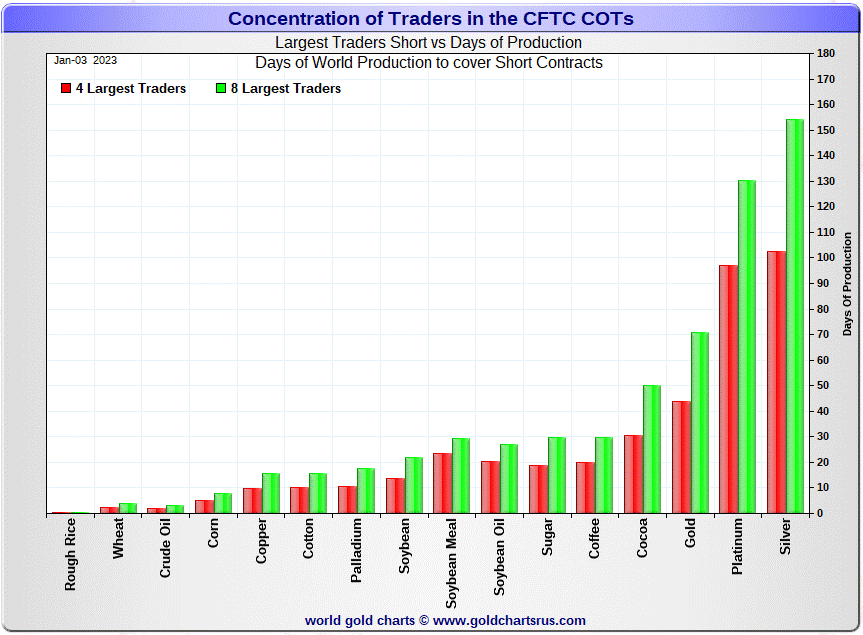
In this week's 'Days to Cover' chart, the Big 4 traders are short about 103 days of world silver production, unchanged from last Friday's COT Report. The ‘5 through 8’ large traders are short an additional 51 days of world silver production, also from last Friday's COT Report, for a total of about 154 days that the Big 8 are short -- and also unchanged from last Friday's COT Report.
These unchanged numbers should come as no surprise considering the paltry changes in the Big 4/8 categories as discussed in the COT Report for silver further up.
That 154 days that the Big 8 traders are short, represents 5 months and a bit of world silver production, or 331.30 million troy ounces/66,259 COMEX contracts of paper silver held short by these eight commercial traders. The two or three largest of these are now non-banking entities, as per Ted's discovery in December's Bank Participation Report.
The 16 small commercial traders other than the Big 8 commercial shorts... Ted's raptors...are net long silver by around 110.3 million troy ounces/22,050 COMEX contracts...down about 6.6 million troy ounces from last Friday's COT Report.
In gold, the Big 4 are short 44 days of world gold production, up about 1 day from the last COT Report. The '5 through 8' are short 27 days of world production, unchanged from last Friday's report...for a total of 71 days of world gold production held short by the Big 8 -- and obviously up 1 day from the prior COT Report.
The Big 8 traders are short 50.2 percent of the entire open interest in silver in the COMEX futures market, down a bit from the 51.6 percent that they were short in last Friday's COT Report. And once whatever market-neutral spread trades they have on are subtracted out, that percentage would be something over the 55 percent mark. In gold, it's 47.0 percent of the total COMEX open interest that the Big 8 are short, almost unchanged from the 47.2 percent they were short in the prior COT Report -- and a bit under the 55 percent mark, once their market-neutral spread trades are subtracted out.
I'll continue to remind you that Ted is still of the opinion that Bank of America is short about one billion ounces of silver in the OTC market, courtesy of JPMorgan & Friends -- and in the latest report from the OCC report of six weeks ago...for positions held as of 30 September...Ted says they've increased their short position by a further 64%...which he said was probably an increase in market-neutral gold spread trades to hide their glaring short position in silver. Goldman Sachs also has a derivatives position in silver in that market. But Ted says that the latest OCC report shows that they've cut it by 90 percent from the prior OCC Report. Both JPMorgan and Citigroup cut their precious metals derivatives by around 15% each.
Of course that OCC Report was for positions held as of the end of September -- and it's a very safe bet that a lot has changed [most likely in a good way] over the last three months...but we won't find out what those changes are until around the end of February.
And not to be forgotten is the 50.36 million troy ounce short position in SLV...as of the short report on December 27. That's an 11% increase from the prior short report. The next short report is due out on Wednesday, January 11.
The situation regarding the Big 4/8 concentrated commercial short positions in silver and gold is still obscene. But on the other side of the Big 8 short coin are Ted's raptors...the small commercial traders other than the Big 8 shorts.
They're still net long silver by around 22,050 COMEX contracts -- and net long gold by around 51,240 contracts...as of yesterday's COT Report.
As Ted has been pointing out ad nauseam forever, the resolution of the Big 4/8 short positions will be the sole determinant of precious metal prices going forward. And as I pointed out a couple of times further up, they have been very reluctant to added to their short positions over the last month or so, despite their respective ongoing rallies.
And, as always, nothing else matters -- and that should now be obvious to all by now, except the willfully blind, of course...plus those whose so-called reputations and careers depend upon them not seeing it...as I keep pointing out.
![]()
The January Bank Participation Report [BPR] data is extracted directly from yesterday's Commitment of Traders Report. It shows the number of futures contracts, both long and short, that are held by all the U.S. and non-U.S. banks as of Tuesday’s cut-off in all COMEX-traded products. For this one day a month we get to see what the world’s banks have been up to in the precious metals.
[The January Bank Participation Report covers the time period from December 6 to January 3 inclusive.]
In gold, 5 U.S. banks are net short 55,891 COMEX contracts in the January BPR. In December’s Bank Participation Report [BPR] these same 5 U.S. banks were net short 51,071 contracts, so there was an increase of 4,820 COMEX contracts month-over-month. These U.S. banks haven't been this short gold since June's BPR...which was for May.
Citigroup, HSBC USA, Bank of America and Morgan Stanley would most likely be the U.S. banks that are short this amount of gold...plus one other...maybe Goldman. I still have my usual suspicions about the Exchange Stabilization Fund, although if they're involved, they are most likely just backstopping these banks if they get to the 'too big to fail' stage over this.
Also in gold, 23 non-U.S. banks are net short 39,152 COMEX gold contracts. In December's BPR, these same 23 non-U.S. banks were net short 30,693 contracts...which is an increase of 8,459 contracts. These non U.S. banks haven't been this short gold since the March BPR, which was for February.
At the low back in the August 2018 BPR...these same non-U.S. banks held a net short position in gold of only 1,960 contacts -- so they've been back on the short side in an enormous way ever since.
I suspect that there are at least four large banks in this group, HSBC, Barclays and Standard Chartered and also BNP Paribas. I still harbour suspicions about Scotiabank/Scotia Capital, Dutch Bank ABN Amro -- and Australia's Macquarie Futures. Other than that small handful, the short positions in gold held by the vast majority of non-U.S. banks are immaterial and, like in silver, have always been so.
As of this Bank Participation Report, 28 banks [both U.S. and foreign] are net short 21.1 percent of the entire open interest in gold in the COMEX futures market, which is up a bit from the 19.3 percent that 29 banks were net short in the December BPR.
But as Ted discovered in December's BPR, the two or three largest of the Big 8 shorts, are now non-banking entities -- and that puts the banks way down the list in the Big 8 category. I'll have more on this a bit further down.
Here’s Nick’s BPR chart for gold going back to 2000. Charts #4 and #5 are the key ones here. Note the blow-out in the short positions of the non-U.S. banks [the blue bars in chart #4] when Scotiabank’s COMEX short position was outed by the CFTC in October of 2012. Click to enlarge.
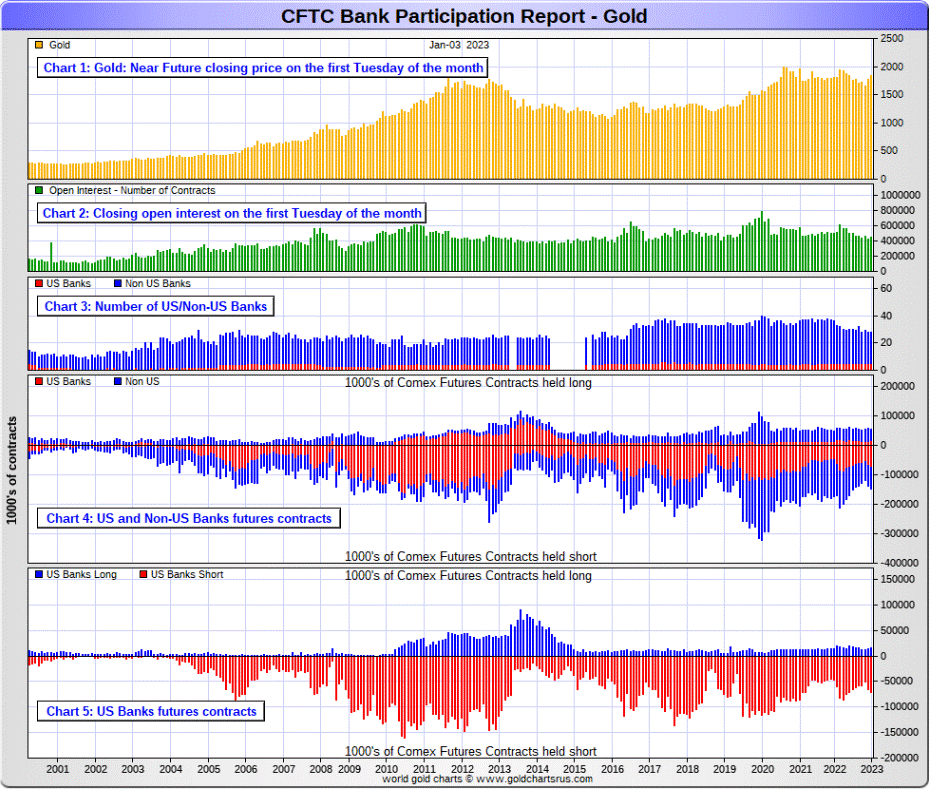
In silver, 5 U.S. banks are net short 27,877 COMEX contracts in January's BPR. In December's BPR, the net short position of these same 5 U.S. banks was 26,695 contracts, which is up an insignificant 1,182 COMEX contracts from the prior month. These banks haven't been this short silver since June's BPR...which was for the month of May.
The biggest short holders in silver of the five U.S. banks in total, would be Citigroup, HSBC USA, Bank of America, Morgan Stanley...and maybe Goldman Sachs. And, like in gold, I have my suspicions about the Exchange Stabilization Fund's role in all this...although, also like in gold, not directly.
Also in silver, 17 non-U.S. banks are net short 17,885 COMEX contracts in the January BPR...which is up a piddling 382 contracts from the 17,503 contracts that 16 non-U.S. banks were net short in the December BPR.
I would suspect that HSBC and Barclays hold a goodly chunk of the short position of these non-U.S. banks...plus some by Canada's Scotiabank/Scotia Capital still. I'm not sure about Deutsche Bank... but now suspect Australia's Macquarie Futures. I'm also of the opinion that a number of the remaining non-U.S. banks may actually be net long the COMEX futures market in silver. But even if they aren’t, the remaining short positions divided up between the other 12 or so non-U.S. banks are immaterial — and have always been so.
As of January's Bank Participation Report, 22 banks [both U.S. and foreign] are net short 34.6 percent of the entire open interest in the COMEX futures market in silver — down a tiny bit from the 36.1 percent that 21 banks were net short in the December BPR. [Note: The reason that this number shows a decrease, rather than an increase, was because total silver open interest declined a lot over the last month.] And much, much more than the lion’s share of that is held by Citigroup, HSBC, Bank of America, Barclays, Scotiabank -- and possibly one other non-U.S. bank...all of which are card-carrying members of the Big 8 shorts.
I'll point out here that Goldman Sachs, up until late in 2021, had no derivatives in the COMEX futures market in any of the four precious metals. But they did show up in the last four OCC Reports. Ted thinks they're long silver in the OTC market. I shan't bother talking about the 1 billion troy ounce short position that Bank of America is short in the OTC market...thanks to JPMorgan & Friends, as I've already covered that ground further up.
Here’s the BPR chart for silver. Note in Chart #4 the blow-out in the non-U.S. bank short position [blue bars] in October of 2012 when Scotiabank was brought in from the cold. Also note August 2008 when JPMorgan took over the silver short position of Bear Stearns—the red bars. It’s very noticeable in Chart #4—and really stands out like the proverbial sore thumb it is in chart #5. But, according to Ted, as of March 2020...they're out of their short positions, not only in silver, but the other three precious metals as well. Click to enlarge.
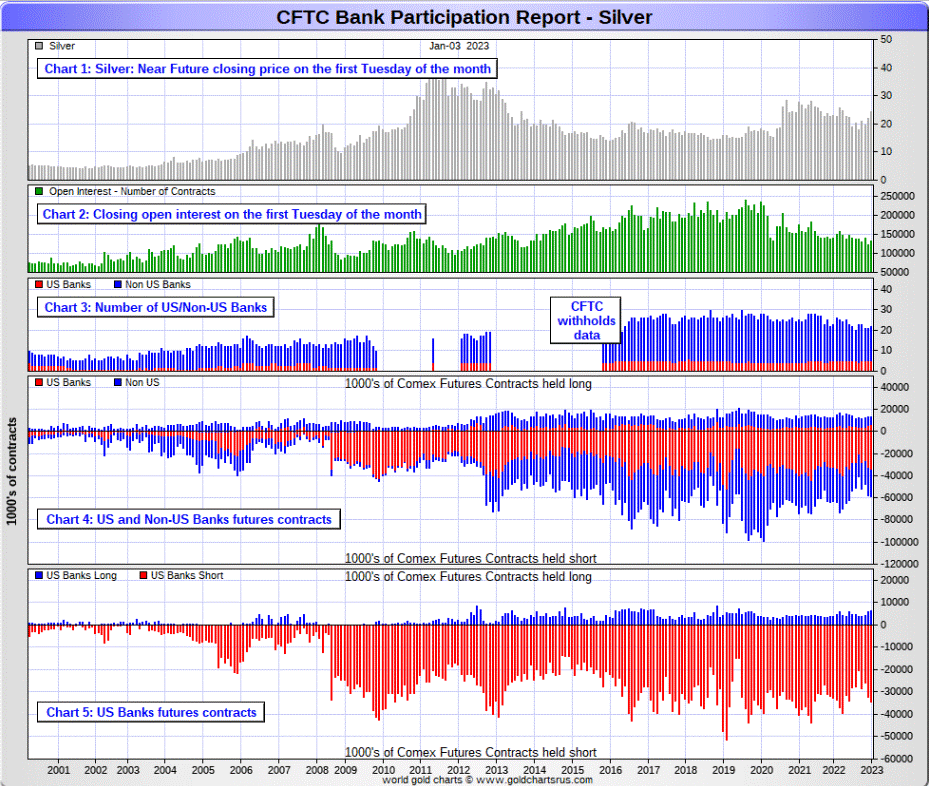
In platinum, 5 U.S. banks are net short 20,151 COMEX contracts in the January Bank Participation Report, which is up another 1,476 contracts from the 18,675 COMEX contracts that these same 5 U.S. banks were short in the December BPR. They haven't been this short platinum since January of 2020.
At the 'low' back in September of 2018, these U.S. banks were actually net long the platinum market by 2,573 contracts. So they have a very long way to go to get back to just market neutral in platinum...if they ever intend to, that is.
Also in platinum, 17 non-U.S. banks are net short 4,600 COMEX contracts in the January BPR, which is down a piddling 73 contracts from the 4,673 contracts that 15 non-U.S. banks were net short in the December BPR. These non-U.S. banks haven't been this short platinum since June 2021.
And as of January's Bank Participation Report, 22 banks [both U.S. and foreign] are net short 35.5 percent of platinum's total open interest in the COMEX futures market, which is up a bit from the 33.9 percent that 20 banks were net short in December's BPR.
So the higher the platinum price has risen, the more the world's bullion banks have been going short over the last few months...the U.S. bullion banks in particular.
So it's obvious that the U.S. banks that are on the short hook big time -- and the real price managers. They have little chance of delivering into their short positions, although a very large number of platinum contracts have already been delivered during the last few years. But that fact, like in both silver and gold, has made no difference whatsoever to their paper short positions. The situation for them [the U.S. banks] in this precious metal is as almost as equally dire in the COMEX futures market as it is with the other two precious metals...silver and gold...particularly the former.
Platinum remains the Big commercial shorts' No. 2 problem child after silver... as per the above 'Days to Cover' chart. How it will ultimately be resolved is unknown, but most likely in a paper short squeeze, as the known stocks of platinum are minuscule compared to the size of the short positions held -- and that's just the short positions of the world's banks I'm talking about here.
Here's the Bank Participation Report chart for platinum. Click to enlarge.
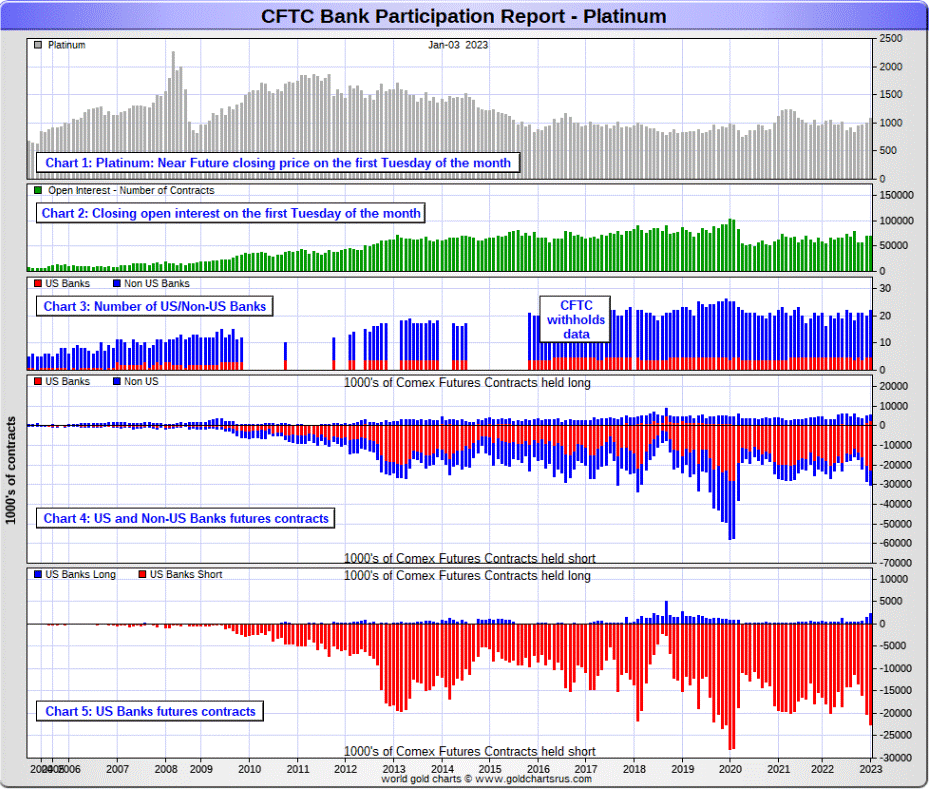
In palladium, 4 U.S. banks are now net long 264 COMEX contracts, up from the 65 COMEX contracts that these same 4 U.S. banks were net short in December's BPR.
Also in palladium, 11 non-U.S. banks are net long 187 COMEX contracts in the January BPR, down 28 contracts from the 215 contracts that these same non-U.S. banks were net long in December.
These palladium numbers held by the bullion banks of the world are meaningless in the grand scheme of things.
As I've been commenting on for almost forever, the COMEX futures market in palladium is a market in name only, because it's so illiquid and thinly-traded. Its total open interest in yesterday's COT Report was only 8,456 contracts... compared to 69,687 contracts of total open interest in platinum... 131,990 contracts in silver -- and 449,393 COMEX contracts in gold.
The only reason that there's a futures market at all in palladium, is so that the Big 8 commercial traders can control its price. That's all there is, there ain't no more.
As of this Bank Participation Report, 15 banks [both U.S. and foreign] are net long 5.4 percent of the entire COMEX open interest in palladium... compared to the 1.9 percent of total open interest that these same 15 banks were net long in December's BPR.
And because of the small numbers of contracts involved, along with a tiny open interest, these numbers are pretty much meaningless as well.
But, having said that, for the last three years in a row now, the world's banks have not been involved in the palladium market in a material way. And with them now net long by a microscopic amount, it's all hedge funds and commodity trading houses that are left net short.
Here’s the palladium BPR chart. Although the world's banks are now net long at the moment, it remains to be seen if they return as big short sellers again at some point like they've done in the past. Click to enlarge.
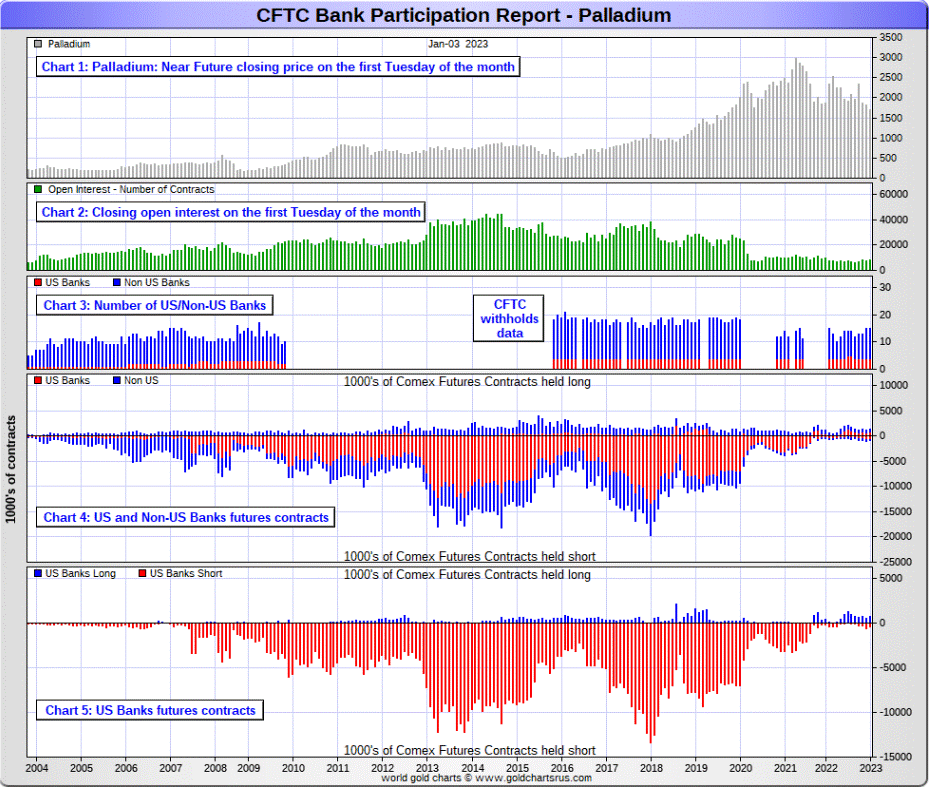
Excluding palladium for obvious reasons...only a small handful of the world's banks, most likely four or so in total -- and mostly U.S.-based, except for HSBC, Barclays and maybe Standard Chartered...continue to have meaningful short positions in the precious metals. It's a near certainty that they run this price management scheme from within their own in-house/proprietary trading desks...although it's a given that some of their their clients are short these metals as well.
The futures positions in silver and gold that JPMorgan holds are immaterial -- and have been since March of 2020...according to Ted Butler. And what net positions they might hold, would certainly be on the long side of the market.
It's the new 7+1 shorts et al. that are on the hook in everything precious metals-related...which now, as of December's BPR, includes two or three non-banking entities that have taken over the biggest of the short positions.
In this Bank Participation Report, it doesn't look like these new non-banks shorts did much, at least that's the impression I got from looking at the numbers -- and what Ted hinted at on the phone yesterday. But as he also said, the fact that there weren't much in the way of changes month-over-month, doesn't alter the premise that the composition of the Big 8 shorts has undergone his profound 'sea change'.
And as has been the case for years now, the short positions held by the Big 4/8 traders/banks, is the only thing that matters...especially the short positions of the Big 4 -- and how this is ultimately resolved [as Ted said earlier] will be the sole determinant of precious metal prices going forward.
The Big 8 shorts, along with Ted's raptors...the small commercial traders other than the Big 8 commercial shorts...continue to have an iron grip on their respective prices -- until they don't. At this point in time, nothing appears to have changed in that regard, except for the fact that they appear more than reluctant to add much in the way of new short...particularly in silver.
Considering the current state of affairs in the world today -- and the physical shortage in silver -- and most likely in gold now as well, the chance that these big bullion banks could get overrun at some point is certainly within the realm of possibility if things go totally non-linear in other areas outside of the precious metals.
I have a fairly decent number of stories, articles and videos for you today.
![]()
CRITICAL READS
2022 U.S. auto sales were the worst in more than a decade
Automakers are hopeful last year’s new vehicle sales — the worst in more than a decade — will mark a bottom for the market, at least in the near term.
Industry estimates range from 13.7 million to 13.9 million new vehicles being sold last year in the U.S., a roughly 8% to 9% decline compared with 2021 and the lowest level since 2011 when sales were recovering from the Great Recession.
Sales varied widely by automaker, as parts and supply chain problems affected companies at different times, but most — with General Motors’ 2.5% gain as a notable exception — were down compared with 2021. Ford Motor, Hyundai and Kia all reported low single-digit declines. Toyota Motor was down 9.6%, while Stellantis, Nissan and Honda Motor posted double-digit falls of 13%, 25% and 29.4%, respectively.
Toyota and GM said they expect U.S. auto sales to increase to about 15 million vehicles this year. That would be a roughly 9% increase over 2022. S&P Global Mobility and Edmunds expect 2023 new U.S. vehicle sales to be 14.8 million, while Cox Automotive’s preliminary forecast is 14.1 million.
“We’re cautiously optimistic about the future. In 2023, there will be an uptick not quite as high as we would love it to be but going the right direction,” Jack Hollis, executive vice president of Toyota Motor North America, said during a briefing Wednesday. “Demand is still higher than our supply.”
These guys are dreaming in Technicolor if they thing that this year will be an improvement over last year. The CNBC story was posted on their website at 6:00 a.m. EST on Friday morning -- and has obviously been rewritten and given a new headline since. I thank Swedish reader Patrik Ekdahl for sending it along -- and another link to it is here.
![]()
Inside The "Strong" Jobs Report: Full-Time Workers -1K; Part-Time Workers +679K
Reading the mainstream media's reaction to today's payrolls report, one would be left with the impression that it was generally on the Goldilocks side and indicative of a possible soft-landing - consider this from Bloomberg: "the U.S. labor market stayed resilient last month while wage gains cooled, raising hopes that the economy may dodge a recession and the Federal Reserve will further slow its aggressive campaign of interest-rate hikes."
Which is accurate: wage growth indeed slowed down following a major revision to the data (remember that 0.6% M/M jump in average hourly earnings that freaked out the market last month? Well, it was quietly revised to 0.4% today), and as a result - as even Fed mouthpiece Nick Timiraos pointed out earlier - "Revisions to average hourly earnings data paint a marginally less worrisome picture for the Fed on wages than the Nov report. The upturn in wage growth in Nov (originally reported as +0.6%) was revised (to +0.4%). The 4.6% annual wage growth in Dec was the lowest since Aug '21."
The drop in wage growth was consistent with the warning from the ADP earlier this week, which found that December ushered in "the largest decline in pay growth for job stayers in the three-year series history" (and even job-changers saw a modest drop in wage growth).
There was more: not only did average hourly earnings drop, but so did average hours worked, which has a major impact on the average wages, and had hours been flat, the decline in average wages would have been even more pronounced.
OK, so wages are finally starting to reflect reality - and indicating that inflation pressures are clearly easing, which is to be expected for any economy sliding into a recession.
But what about the underlying issues with the jobs data? What about that massive divergence between the employment number (from the Household Survey) and the monthly payrolls change (from the Establishment survey).
Recall that it was just last month that we reported that divergence between these two data sets hit a record 2.7 million, a difference which got added focus just a few days later after the Philadelphia Fed reported that its own calculations found that in Q2 the U.S. added just 10,000 jobs, not the 1.1 million reported by the BLS.
This longish and chart-filled commentary appeared on the Zero Hedge website at 11:20 a.m. EST on Friday morning -- and another link to it is here.
![]()
ISM Services Slumps Into Contraction, Factory Orders Plunge Most Since COVID
After a surprise bounce in November (and following S&P Global's Services PMI weakness), analysts expected ISM Services survey to show deterioration in December and they were right but the magnitude was very significant. ISM Services tumbled into contraction at 49.6 (vs. 55.0 expected) from 56.5 in November. That is the biggest drop since 2020 and the first contraction since May 2020...Click to enlarge.
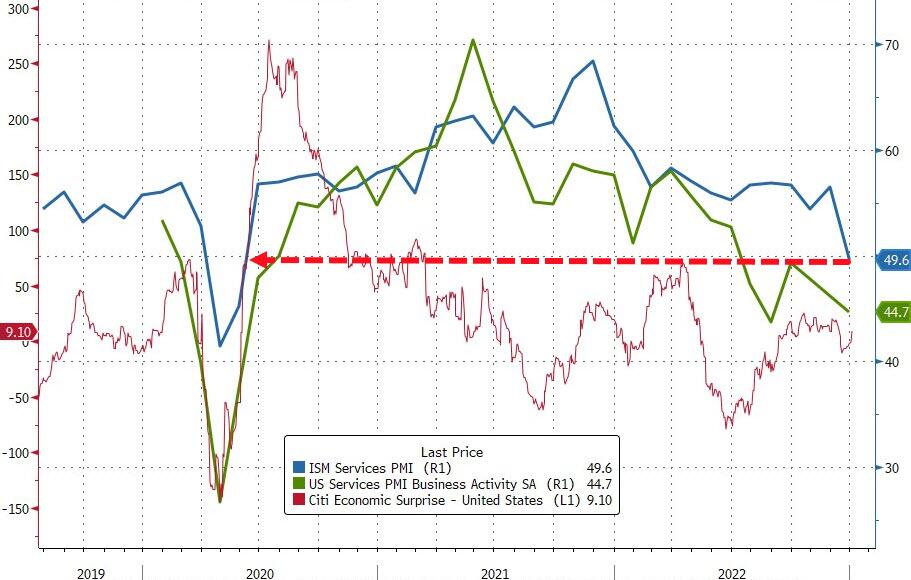
ISM Services New Orders collapsed...
Across both ISM and PMI and Services and Manufacturing sides of the economy, December saw weakness accelerating with all in contraction...
Notably, The Fed is usually easing when this is happening...
Broadly speaking, ISM respondents are wary of inflation and slowdown signals...
Meanwhile, on the other side of the economy, factory orders plunged more than expected in December (-1.8% vs. -1.0% expected)...
That is the biggest drop since April 2020 (peak COVID lock-downs).
So, in December, both sides of the economy saw significant weakness accelerating... and yet unemployment rates plunged?
This 4-chart Zero Hedge story showed up on their Internet site at 10:07 a.m. on Friday morning EST -- and I thank Brad Robertson for sharing it with us. Another link to it is here.
![]()
Total assets on the Federal Reserve’s balance sheet dropped by $458 billion since the peak in April, to $8.51 trillion, the lowest since October 6, 2021, according to the weekly balance sheet released today, with balances as of January 4.
Compared to a month ago (balance sheet released on December 8), total assets dropped by $75 billion.
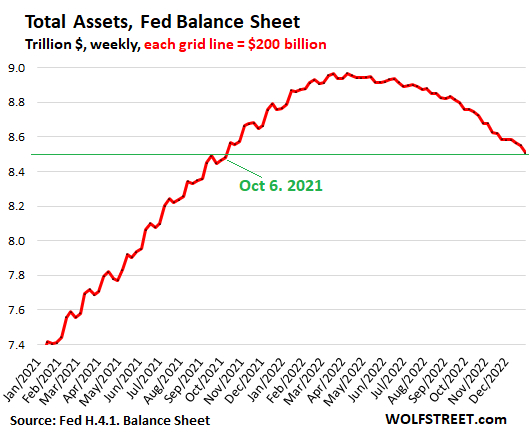
Treasury notes and bonds mature mid-month and at the end of the month, at which point the Fed gets paid face value for them, and they roll off the Fed’s balance sheet.
Since the peak in early June, the Fed’s Treasury holdings fell by $314 billion to $5.48 trillion, the lowest since October 6, 2021. Over the past month, the Fed’s holdings of Treasury securities fell by $57 billion, near the cap of $60 billion.
About half of the $3 billion difference between the cap and the roll-off is due to $1.5 billion of income from inflation protection that is not paid in cash but is added to the principal of Treasury Inflation-Protected Securities (TIPS).
This multi-chart commentary from Wolf put in an appearance on the wolfstreet.com Internet site on Thursday -- and comes to us courtesy of Richard Saler. Another link to it is here. Gregory Mannarino's almost always "ADULT" rated post market close rant from yesterday is linked here -- and comes courtesy of Brad Robertson.
![]()
Bubble: A self-reinforcing, but inevitably unsustainable inflation. Bubbles are a monetary phenomenon, fueled by some underlying source of Credit expansion. If accommodated by loose monetary policy, Bubbles have a proclivity to surprise to the upside – with an escalation to “crazy” excesses during the “Terminal Phase” of “blow-off” excess.
Bubbles eventually burst. The bigger and more prolonged the Bubble, the greater the systemic monetary disorder and associated price distortions, along with deepening financial and economic structural maladjustment. Accordingly, the more ingrained Bubble excess becomes, the more central bankers will be compelled to forestall collapse. Such efforts will only extend “Terminal Phase” excesses, with systemic risk rising exponentially. Importantly, and as understood generations ago by “Austrian” economic thinkers, the pain and dislocation unleashed during the bust is proportional to the excesses of the preceding boom.
Last year marked an inflection point for myriad historic global Bubbles. Some were pierced, and a few of those suffered painful collapses (i.e. crypto). Others were pierced, but persisted. In general, the riskiest of the speculative Bubbles suffered the greatest deflation. Importantly, however, key Credit Bubbles continued to inflate.
Despite Fed tightening measures and surging market yields, extraordinary Credit growth was ongoing in the U.S. A historic lending boom (bank and non-bank), along with notable GSE expansions and deficit spending, fueled system Credit growth likely second only to 2020’s pandemic Credit melee.
In China, continued massive bank lending and fiscal stimulus secured yet another year of double-digit system Credit expansion. The gap between Credit growth and GDP widened alarmingly.
There are reasons to expect moderation this year from both major global Credit engines. Issue 2023: It’s a post-Bubble environment, with Bubble deflation proceeding in earnest, though ongoing strong Credit growth would create the appearance of relative stability. In the event of a meaningful Credit slowdown, an increasingly disorderly unwind of financial and economic excess would be expected.
Doug's longish weekly commentary was posted on his Internet site in the very wee hours of Saturday morning PST -- and another link to it is here.
![]()
A Fed Pivot is Mathematically Assured -- Lawrence Lepard
Lawrence discusses the changing investing landscape as it relates to the Federal Reserve's continuing debasement of the currency and its three mandates of inflation, labor, and financial stability. He notes that the debt situation is becoming increasingly dire, with the interest on the debt doubling in just a few years, the deficit now over two trillion, with tax receipts declining. This debt doom loop will eventually unravel, leading to massive contagion and a complete collapse of financial stability.
He believes that hard money advocates are in the minority, but that if the government were to take responsibility, the current paradigm could be changed. Unfortunately, he notes that the level of understanding required to solve our economic problems is still lacking at a governmental level, and it will take a lot more suffering before awareness is achieved. Inflation is likely to become the number one political issue, at which point sound money advocates may be given a chance to present their solutions. But at present, the Fed is continuing to print more money in an attempt to solve the problems, which will only lead to a further devaluation of bonds and stocks.
This 60-minute video interview with host Tom Bodrovics appeared on the youtube.com Internet site back on December 29 -- and another link to it is here.
![]()
Time to Get Real About Ukraine -- Jim Rickards
The war in Ukraine remains the most important story in the world today.
Don’t believe the incessant U.S. government and media propaganda about Ukraine. Ukraine is not winning the war; they are losing badly.
But wait, hasn’t the news been talking up Ukrainian gains in recent months, while Russia is retreating and being badly beaten? That’s the mainstream, pro-Ukrainian narrative. Here’s the reality:
Most of the Ukrainian gains were against lightly defended positions that the Russians quickly abandoned because they were not worth fighting to defend.
Those Russian troops (really Donbas militias) were ordered to retreat to fortified Russian lines while Ukrainian forces rushing to fill the void were slaughtered by Russian artillery bombardments.
Most people think of war in terms of territory. If you lose territory, it must mean you’re losing the war. But it’s not always that simple.
The Russians will willingly cede territory in order to fight again at a later time under more favorable circumstances. They’ll simply retake it when the terms favor them. They’re not primarily concerned about the territory per se. The primary Russian objective is to grind down and destroy the Ukrainian armed forces.
And if the Ukrainians want to keep hurling themselves against Russian positions in order to recapture land and score a propaganda coup, that’s fine with the Russians. They’ll just grind the attacking forces down with heavy artillery fire (artillery kills far more people in war than bullets or bombs).
This interesting and worthwhile commentary from Jim showed up on the dailyreckoning.com Internet site a couple of days ago -- and I've been saving it for today's column. Another link to it is here. A far more in-depth and darker piece on the current situation in the Ukraine is headlined "The most important question" -- and was written by the proprietor, Andrei Raevsky, over at the saker.is Internet site back on December 27. I thank reader 'Mac P.' for pointing it out -- and the link to it is here.
![]()
Perth Mint's 2022 gold sales rise 10% despite December slump
The Perth Mint's gold product sales in 2022 rose more than 10%, despite halving in December from the previous month, the refiner said in a blog post on Friday.
Monthly sales of gold coins and minted bars dropped to 60,634 ounces last month from 114,304 ounces in November. However, sales were up 10.5% in 2022 from 54,861 ounces seen in the year-ago period.
Neil Vance, general manager for minted products, said the bullion product sales in December were "impacted by less trading days due to Christmas public holidays".
December sales of silver products rose 24% to 1,634,751 ounces month-on-month, while marking an yearly decline of about 6%.
Perth Mint shipped "more-than-expected silver," following the release of their Australian Kookaburra 2023 Silver Coin Series in late November, Vance added.
This Reuters story from Thursday was picked up by the nasdaq.com Internet site -- and I found it on Sharps Pixley. Another link to it is here.
![]()
The Photos and the Funnies
Continuing along Monck Park Road on the north shore of Nicola Lake on June 19, we left the valley flat-land behind and began the climb up the mountainside. My daughter spotted this juvenile bald eagle in a ponderosa pine along the side of the road -- and although I have a fair number of bald eagles photos already, I couldn't pass up the photo op. And while I had the 400mm lens on the camera, I took the third shot looking back across the valley floor that we'd just traversed. B.C. Highway 5A winds along the opposite shore of the lake between Merritt and Kamloops...a very picturesque drive in both directions. Photo four was taken within a few meters of where I took photo three, except it's a wide-angle view. Click to enlarge.





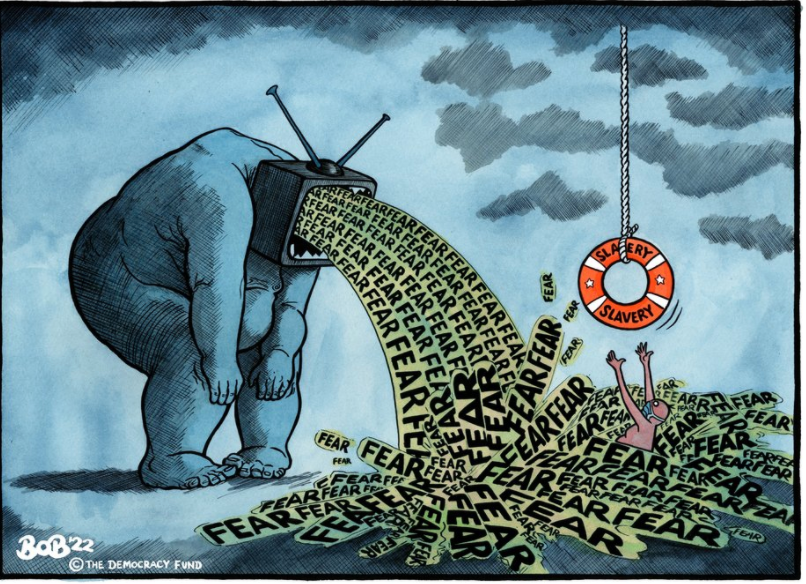
![]()
The WRAP
"Understand this. Things are now in motion that cannot be undone." -- Gandalf the White
![]()
Today's pop 'blast from the past' is 54 years young, which is almost impossible to believe. It was written by American musician Robert Lamm, one of the founding members of the band Chicago. It still gets air time even now -- and here's Moscow-based rock band 'Leonid & Friends' serving it up as good as you're likely to see or hear it. And as always, lead singer Serge Tiagniryadno, is patched in from his home in Kiev, Ukraine. The link is here. Canada's own Constantine Isslamow serves up the bass cover -- and that's linked here.
Today's classical 'blast from the past' is Max Bruch's Violin Concerto No. 1 in G minor, Op. 26 -- and is one of the most popular violin concertos in solo violin repertoire.
The concerto was first completed in 1866 and the first performance was given on 24 April 1866 by Otto von Königslow, with Bruch conducting. The concerto was then considerably revised with help from celebrated violinist Joseph Joachim and completed in its present form in 1867. The premiere of the revised concerto was given by Joachim in Bremen on 7 January 1868.
Here's American virtuoso violinist Hilary Hahn doing the honours, along with the Frankfurt Radio Symphony Orchestra. Maestro Andrés Orozco-Estrada conducts -- and the link is here.
![]()
Friday was an interesting one in the precious metals. Although there certainly was resistance present from the commercial traders of one stripe or another during morning COMEX trading in New York, the volume in gold wasn't overly heavy, all things considered...although the increase in open interest, about 10,500 COMEX contracts, was higher than I would have liked...but suspect some was spread trade related [he says, hopefully].
But the big surprise was in silver, as net volume was only around 52,000 contracts, a shockingly low number considering the price move in it -- and the increase in total open interest on Friday was only 1,400 contracts.
Those numbers, coupled with the tiny 1,564 COMEX contracts that the 22 bullion banks of the world increased their short position by in January's Bank Participation Report, shows you just how reluctant the Big commercial shorts are in adding to their short positions.
Something appears to be up -- and I know that Ted will have something to say about this in his weekly review for his paying subscribers this afternoon. He's more qualifies than I, or anyone else for that matter, of speaking to this ongoing and unfolding 'sea change' he spoke of a month ago.
Gold's closing price on Friday hasn't been seen since around the middle of June last year -- and although silver was closed lower on the week, it finished the Friday session at a price not seen since the third week of April. Neither are close to being overbought on their respective RSI traces on the 6-month charts below -- and in the case of silver, its closer to market neutral, than overbought.
Platinum hasn't been this high in price since the nickel contract blew up on the LME back on March 8 of last year -- and although palladium closed higher on Friday, gaining back all of Thursday's losses...plus a bit more, it's still below any moving average that matters. Except for one or two days in mid November, it's been in that state for the last three month running.
Copper was finally allowed to break above and close above its 200-day moving average...the first time it has closed above it since early June. It finished the Friday trading session at $3.91/pound...up 9 cents on the day...its second decent 'up' day in a row.
Natural gas [chart included] hit an new intraday low for this move down... $3.52 per...but finished the day down only a penny at $3.71/1,000 cubic feet. WTIC didn't do much, closing higher by a dime at $73.77/barrel. Both these crucial commodities continue to languish far below any moving average that matters...particularly natural gas.
Here are the 6-month charts for the Big 6+1 commodities, courtesy of the good folks over at the stockcharts.com Internet site as always -- and yesterday's COMEX closing prices in all should be noted. Click to enlarge.
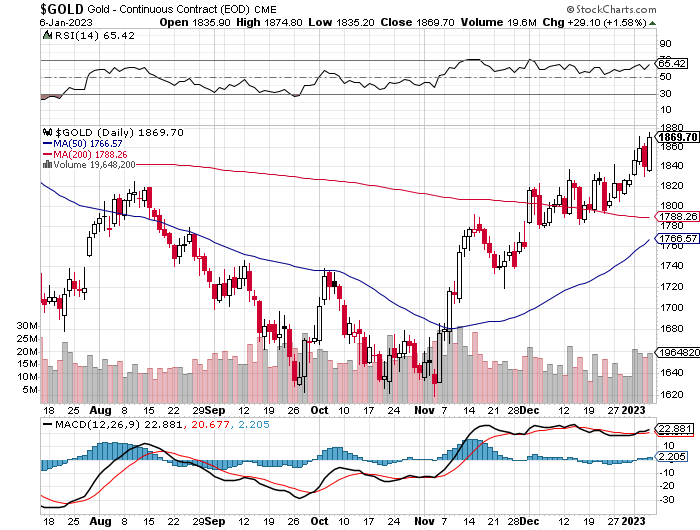
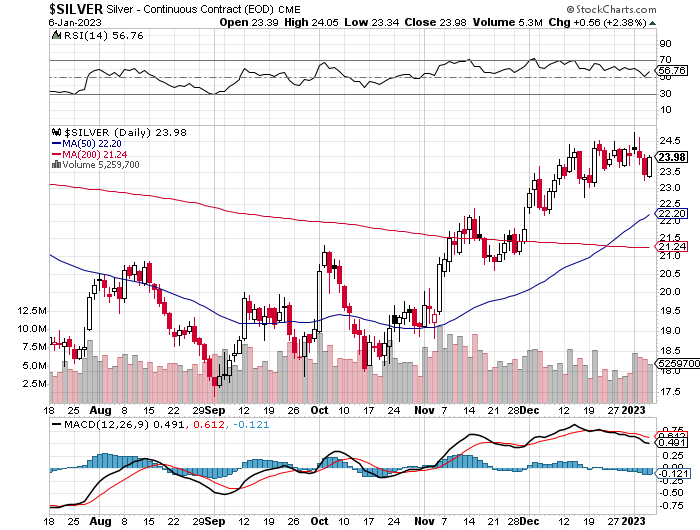
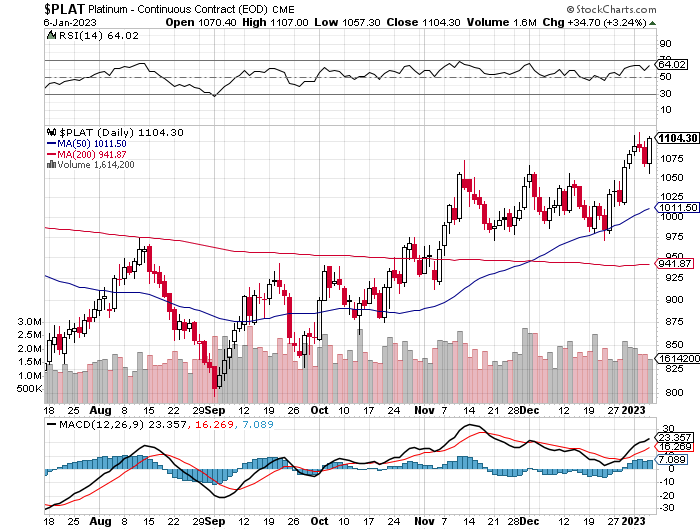
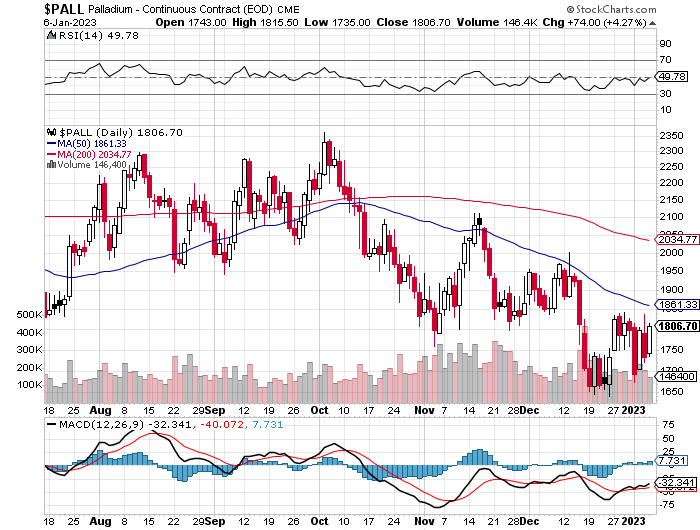
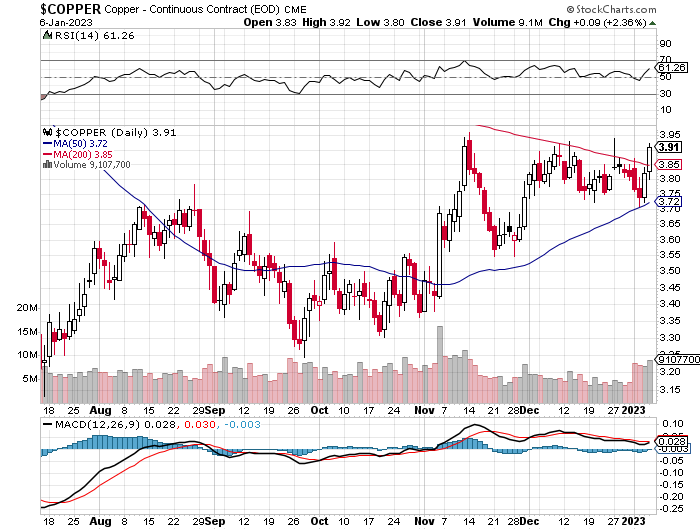
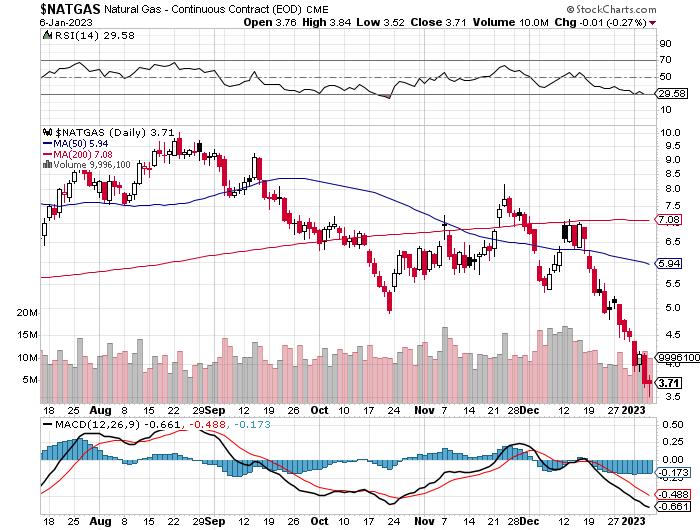
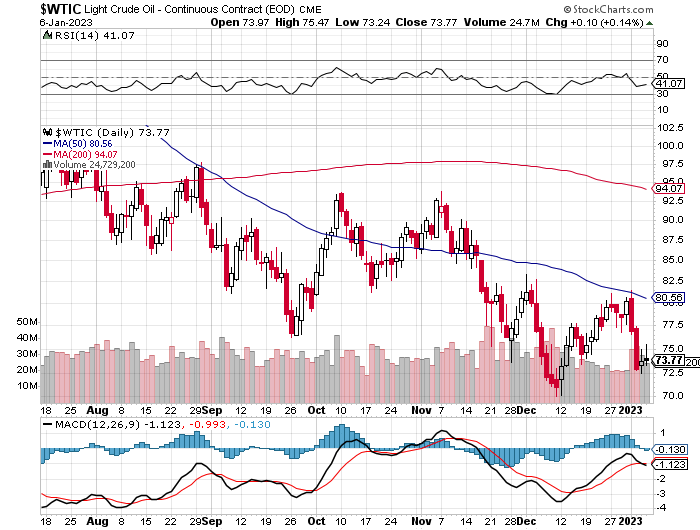
No matter what direction or indicator in the financial world one cares to look at these days, they all point to the same thing...far higher commodity prices in general -- and precious metal prices in particular, are in our future.
The supply/demand fundamentals haven't changed much in the industrial commodities -- and as a main stream media story late in December pointed out, the world's supply of some of them are at critical levels...copper, zinc and aluminum come to mind.
But those three, along with a whole host of others in the industrial metal complex, pale into insignificance when compared to the outrageous supply deficit that already exists in silver -- and has existed for a very long time. That situation could soon erupt in gold as well, if the world's central banks continue to scarf it up in Q4/2022...like the did in Q3. It has now developed into a stealth bank run on gold.
And while on the subject of gold, the announcement that Russia has allowed their sovereign wealth fund to now hold double the amount of gold that they were allowed to hold before, should be a clear sign that most of Russia's domestic gold production will now disappear into it going forward. Silver wasn't mentioned, but I wish it had been.
Returning to silver, the LBMA, COMEX and SLV are not bottomless pits for it, or for gold -- and as Ted has correctly pointed out, the actual working silver inventory on the COMEX is most likely down to a few million ounces. One has to suspect that a similar situation exists on the LBMA.
This state of affairs cannot continue indefinitely...despite what the Big 8 commercial shorts do or do not do in the short term -- and the 'sea change' that Ted spoke of a month ago, is most likely a sign that this price management scheme is on its way out the door.
Another and more immediate sign were the volume figures in both gold and silver on Friday -- and I'm still trying to wrap my head around that almost unbelievable silver number. As a matter of fact, I checked the CME's website again just now to make sure that I hadn't missed something. And no, it's still the same 52,000 net contracts traded.
But on the surface -- and to an average outsider or amateur investor, everything looks normal. They are completely oblivious to the fact that the silver and gold prices have been actively managed for about the last 50 years or so. It's like 'The Matrix'...except in real life.
They have no inkling of the seismic shift that's about to occur, not just in precious metal prices, but of all commodities in general, as last 2+ generations of price management comes to an end -- and in the case of the precious metals, an abrupt end.
The signs of an rather imminent change are creeping up on us -- and although the Big 8 shorts may hold their ground to the bitter end...they will soon discover that the ground has shifted beneath their feet -- and only the 'too big to fail' bullion banks will get rescued...most likely by the Exchange Stabilization Fund, or the Fed. The rest of the shorts will be allowed to burn in a special place in hell.
The only way out of this for all the shorts is if the powers-that-be decided to close the COMEX...an extreme option, I admit -- and allow the precious metals to trade freely, without futures or options contracts attached to them. That would be the end of the COMEX, or at least damage it significantly. The LME got away with a version of that when its nickel contract blew up...but its reputation, never very good at the best of times, blew up with it.
But the nickel market doesn't hold a candle to the two monetary metals -- and as the end approaches -- and it becomes more obvious that it is upon us, one must never underestimate the treachery of those in charge of the financial system in the West. Think draconian.
Whenever that day arrives -- and there's no possible way to avoid it at some point, it will be an historic moment for the ages and, as I have been pointing out for almost forever now, it won't happen in a news vacuum.
So, until that day arrives, all we can do is wait some more.
Hoping that I have all my bases covered...I'm still "all in" -- and will remain that way to whatever end.
See you here on Tuesday.
Ed


